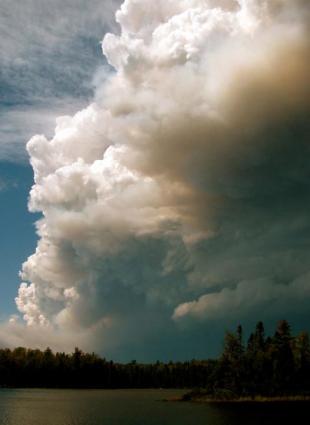West End News: Sept. 15
| Attachment | Size |
|---|---|
| FinalcutWEN_20110915.mp3 | 10.68 MB |
It has been an interesting week here at Sawbill. As you know, the Pagami Creek fire, which started several weeks ago near Ely, has blown up to more than 100,000 acres burned. On Sunday, Sept. 11, the fire made its first big run and we started to pay more attention. On Monday, rain was predicted, but it didn't materialize in time to slow the fire. Instead, winds increased to 20 miles per hour with gusts to 35 miles per hour and the fire made a dramatic 15 mile run. By the end of the day, all the wilderness entry points in the Sawbill area were closed, the Sawbill Campground was evacuated and the upper portion of the Sawbill Trail was closed.
All morning on Monday the wind was out of the south. Here at Sawbill the sun was shining, but we could see a huge plume of smoke to the west. Then, in the early afternoon, the wind started to swing around to the west. The Forest Service called and advised us to start our sprinkler system and evacuate the Sawbill Lake campground. As I was working to get the sprinkler system going, we were suddenly inundated with heavy smoke; it was so heavy we could only see about 30 feet. The wind suddenly increased to 35 mile per hour, it got very dark and then everything turned dark yellow. The sky was yellow, the air was yellow and the smoke was yellow. If that wasn't weird enough, lightning started to flash every few seconds, along with loud thunder, and then it started to pour rain and hail mixed with sodden ash. In my whole life here at Sawbill, I've never seen anything like it. It truly felt like an apocalypse. The rain and hail continued to fall hard for about twenty minutes, which was very welcome at that point in time. The wind continued to shift to the north and just as suddenly as it arrived, the smoke cleared, the rain stopped, and the sun came back out.
On Monday night, the temperature fell dramatically, but on Tuesday morning the Forest Service warned us that it was possible the fire would burn through Sawbill that day. We spent Tuesday morning tuning up the sprinkler system, cleaning rain gutters and raking the pine needles away from building foundations. We were on pins and needles all day as we wondered if the fire would sweep through, but by the end of the day it was clear that the fire had been slowed way down by the rain showers and cooler temperatures. By the end of the day we had pumped more than 50,000 gallons of water onto our property through our sprinkler system. Finally, in the evening the wind shifted again to the north and it actually rained another tenth of an inch. Our intrepid Sawbill crew went to bed tired, but relieved that we had dodged the bullet, at least for the time being.
I'd like to take this opportunity to say that we are just overwhelmed by the support and concern that we received from our community. We literally had over a hundred calls from people offering to come help us, transport things to safety for us, and offering us places to stay if we were evacuated. We all know, of course, that this is a great community, but when you experience an outpouring of community spirit and support first hand, it is profoundly heartwarming. Many thanks to everyone who offered their assistance and concern.
I'd also like to thank and offer some support to our friends and neighbors who work for the U. S. Forest Service. I know that they will receive criticism about their management of the Pagami Lake fire, but I feel like that criticism is somewhat unfair. For more that 30 years we have all understood that fire is a normal part of the ecosystem here in the northern forest region. Historically, every acre of this forest burned at least once every 70 years. After European settlement and the establishment of the timber industry, the Forest Service was charged with aggressively extinguishing every wild fire, no matter what the cause. The forest managers got pretty good at fire suppression over the years. Over time, scientists came to realize that the policy of suppressing all fires was just setting the stage for disastrous, destructive fires, which since 1988 have been referred to as "Yellowstone" type fires. Now there is no longer any doubt that fire must be allowed on the landscape, or the forest as we know it will eventually cease to exist. Over the last 20 years or so, forest managers have developed a much smarter, nuanced approach to how they manage fire. They have been remarkably successful with this new approach and have made a lot of progress, especially in the wilderness, toward their goal of maintaining a healthy forest eco-system. That said, fire management often hinges on accurately predicting the weather, which carries an inherent risk. I think the Forest Service does a remarkable job with fire, but they are only human and nature will occasionally humble any human, no matter how skilled. I would urge the critics to look at the big picture, learn as much as possible about fire policy, and remember that hindsight is 20-20 and it's much easier to judge the future once it has passed. Since I had my first conversation with legendary fire ecologist Bud Hinsleman, I've known that wildfire in this part of the world isn't a matter of "if", it's just a matter of "when."
Here's hoping that next week, there will be a more ordinary West End News.
Tweet




